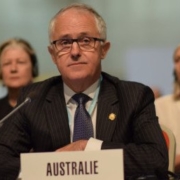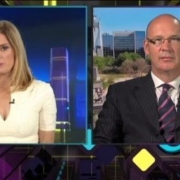
Trade ministers Simon Birmingham and Enggartiasto Lukita sign a memorandum of understanding in August 2018, as Prime Minister Scott Morrison and President Joko Widodo look on. Photo by Timothy Tobing/DFAT.
A decade in the making, the Indonesia-Australia Comprehensive Economic Partnership Agreement (IA-CEPA) comes into force today. Signed on 4 March 2019, the agreement passed its last hurdle in May, undergoing domestic ratification in Indonesia and Australia.
While concerns that Covid-19 could stall the IA-CEPA’s entry into force proved unfounded, some problems remain. For example, several strategies in the 100-day action plan for implementation announced by Prime Minister Scott Morrison and President Joko “Jokowi” Widodo rely on face-to-face activity and travel. These will now need to be reconsidered.
Despite this, there may also be increased opportunities in the wake of Covid-19, as sectors that have been traditionally resistant to trade and investment open up. For example, the IA-CEPA may assist businesses to address higher demand for health care and technological skills in an increasingly digital environment.
As these opportunities arise and the IA-CEPA comes into force, it is worth taking a closer look at the agreement and how it could evolve over the coming years. One aspect that warrants particular attention is its investor state dispute settlement (ISDS) mechanism.
Arising from bilateral or multilateral investment treaties, ISDS is a mechanism for foreign investors to access an international tribunal to resolve investment disputes with the state in which they have invested. While ISDS is not a new concept, in recent years ISDS cases have significantly increased, with Indonesia being subject to multiple ISDS claims including one in excess of US$1 billion.
This is a key reason why Indonesia has reconsidered its approach to ISDS, allowing tens of bilateral investment treaties (BITs) to lapse to make way for new agreements. Indonesia’s new approach includes imposing more exclusion clauses and greater limits on investors’ ability to access ISDS. This approach is seen in the IA-CEPA, which will replace Australia and Indonesia’s existing ISDS mechanism under the Indonesian-Australian 1992 BIT.
The IA-CEPA also stipulates that Indonesia and Australia are prohibited from expropriating or nationalising a foreign investment or undertaking measures equivalent to expropriation or nationalisation (Article 14.11). This would cover both direct and indirect expropriations: that is where the state directly seizes or confiscates investment property or where a government measure results in the total or near total deprivation of the foreign investor’s property or its benefits.
However, there are several limits on the prohibition in Article 14.11. For example, expropriation will be lawful where it was for a public purpose, conducted in a non-discriminatory manner, and compensation was paid to the investor in accordance with due process of law. Indonesian governments have in the past sometimes used notions of ‘economic sovereignty’ and state control of resources in Article 33 of the Indonesian constitution to justify appropriating foreign investor property. If this happened again, it might not be contrary to Article 14.11 of the IA-CEPA, so long as the government compensated the foreign investors affected.
One interesting provision that seeks to protect states’ freedom to regulate is Article 14.16: often described as the balancing provision. This provision provides that nothing in the investment chapter of the IA-CEPA can prevent Indonesia or Australia from adopting, maintaining or enforcing any measure “otherwise consistent” with the investment chapter that is intended to ensure investment activity is undertaken in a manner sensitive to “environmental, health, public morals, social welfare, consumer protection or the promotion and protection of cultural diversity or other regulatory objectives”. This type of clause is present in a number of other investment agreements such as the Trans-Pacific Partnership Agreement (TPP).
The use of “otherwise consistent” in the chapter containing Article 14.16 is significant. It could be argued that this type of wording is self-defeating, in that it effectively negates any real protection for states freedom to regulate. But on the other hand, some commentators assert that it can be taken as a quasi-declaratory provision, communicating the importance of these regulatory objectives.
Importantly, the balancing provision could also be used for the interpretation of other provisions in the investment chapter, emphasising the need for the ISDS tribunal to consider the regulatory objectives outlined in Article 14.16 in any decisions.
The balancing provision is just one of the articles that seek to protect states’ freedom to regulate. For example, IA-CEPA also expressly excludes ISDS claims where the measures that cause expropriation are designed to protect and promote public health (Article 14.21).
But Article 14.16 is particularly interesting because of its express recognition of the need to consider “public morals” – an objective not featured in the equivalent TPP provision.
This is concerning given Indonesia’s history of regulating morality, for example, through controversial anti-pornography laws and lack of protection for the lesbian, gay, bisexual and transgender community, reflective of the tension between human rights and religious values in the country. Indonesia’s prohibition of blasphemy also continues to regulate what is and isn’t “morally appropriate” behaviour.
In another example of the tension between public morality and business interests, in late June, Indonesians flooded Unilever’s Instagram account with thousands of comments advocating for a boycott of the company over its support of LGBTQI+ rights. While ISDS will only be available if a government measure affects an investor’s interests, the Indonesian government’s response to these types of events could potentially fall into regulating for “public morals”.
Other provisions in the investment chapter, such as the exclusion of ISDS claims arising from public health measures, could therefore be interpreted in light of Indonesia’s freedom to regulate on the basis of “public morals”. This could create an interesting dynamic given increased opportunities for investment in the health industry.
The balancing provision also raises questions about who would be responsible for defining “public morals” in Indonesia. Time and again, fatwa from the Indonesian Council of Ulama (MUI) have been accepted in domestic courts as evidence of what constitutes blasphemy. Could an ISDS case see international arbitrators consider MUI fatwa to determine what constitutes “public morals”? Such an outcome would see MUI’s sphere of influence widen even further. How would Indonesia react if international arbitrators refused to accept MUI fatwa? What alternative assessments of public morals might be used?
Only when claims are brought under the IA-CEPA will we see further clarification about how these provisions are to be interpreted. Until then, would-be investors should keep them in mind as Indonesia continues its efforts to attract foreign investment while wrestling with morality, religion and human rights.










